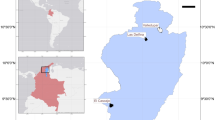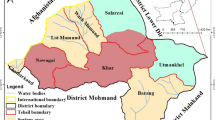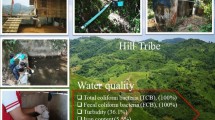Abstract
The quality of the water consumed by a given community is related to its quality of life. In this sense, this study aimed to evaluate, from the perspective of health risk, the physical, chemical, and microbiological quality of drinking water, in a quilombola community, and the qualitative aspects intrinsic to its use and storage. For this, water samples, collected at the exits of the collective water supply system and from eight cisterns that store rainwater, used for human consumption, were analyzed. The samples were subjected to physical, chemical, and microbiological analysis, including adenovirus (HAdV) and enterovirus (EV). The probability of an individual acquiring infection through water consumption was determined by quantitative microbiological risk analysis using HAdV and Escherichia coli (EC) as reference pathogens. The results showed that the water in the deep tubular well had 270.8 mg/L of total hardness, leading to the rejection of its consumption by ingestion. Alternativity, the people in the community consume rainwater stored in cisterns. For this type of water, the presence of heterotrophic bacteria was found in 75%, total coliform was present in 100%, and Enterococci were detected in 25%. Furthermore, EC was present in 25%, EV in 50%, and HAdV in 100% of the samples. The probability of annual infection with HAdV and EC was, in the worst situation, 100% and 1.3%, respectively. Regarding the qualitative and quantitative aspects, there was a significant positive correlation between the absence of EC and the withdrawal of water from the cistern using a pump and the opposite when the withdrawal was carried out using a bucket or hose. Based on the results found, it is important to carry out actions aimed at improving water quality and, consequently, the quality of life of people living in the study community.






Similar content being viewed by others
Data availability
All data generated or analyzed during this study are included in this published article (and its supplementary information files).
References
ABNT (1989) NBR 10739: Determinação de Oxigênio Consumido: Método do Permanganato de Potássio. Associação Brasileira de Normas técnicas, Rio de Janeiro
Abuelfutouh NAK, Jamie M, Nour A, Fuad NI (2020) Rainwater harvesting quality assessment and evaluation: IIUM case study. IIUM Eng J 21:12–22. https://doi.org/10.31436/iiumej.v21i1.1139
Ahmad T, Arshad N, Adnan F, Sadaf Zaidi NUS, Shahid MT, Zahoor U, Afzal M, Anjum S (2016) Prevalence of rotavirus, adenovirus, hepatitis a virus and enterovirus in water samples collected from different region of Peshawar, Pakistan. Ann Agric Environ Med 23:576–580. https://doi.org/10.5604/12321966.1226849
Ahmed W, Gardner T, Toze A (2011) Microbiological quality of roof-harvested rainwater and health risks: a review. J Environ Qual 40:13–21. https://doi.org/10.2134/jeq2010.0345
Al-Batsh N, Al-Khatib IA, Ghannam S et al (2019) Assessment of rainwater harvesting systems in poor rural communities: a case study from Yatta Area, Palestine. Water (Switzerland) 11:1–15. https://doi.org/10.3390/w11030585
APHA-AWWA-WEF (2012) Standard methods for examination of water and wastewater, 22th Editi. American Public Health Association, Washington, D.C.
ASA Brasil (2020) Articulação do Semiárido. Programa Um Milhão de Cisternas. http://www.asabrasil.org.br/acoes/p1mc
Asghari FB, Jaafari J, Yousefi M, Mohammadi AA, Dehghanzadeh R (2018) Evaluation of water corrosion, scaling extent and heterotrophic plate count bacteria in asbestos and polyethylene pipes in drinking water distribution system. Hum Ecol Risk Assess Int J 24(4):1138–1149. https://doi.org/10.1080/10807039.2017.1407632
Asghari FB, Pakdel M, Mohammadi AK, Yousefi M (2019) Spatial and temporal variation of physicochemical and microbial quality of drinking water for the distribution network in Maku, Iran. Desalin Water Treat 142:82–89. https://doi.org/10.5004/dwt.2019.23365
Bae S, Maestre JP, Kinney KA, Kirisits MJ (2019) An examination of the microbial community and occurrence of potential human pathogens in rainwater harvested from different roofing materials. Water Res 159:406–413. https://doi.org/10.1016/j.watres.2019.05.029
Brasil (2013) Lei No 12.873/2013. Institui o Programa Nacional de Apoio à Captação de Água de Chuva e Outras Tecnologias Sociais de Acesso à Água - Programa Cisternas. Brasil
Brasil (2017) Portaria de Consolidação N°5, anexo XX. Dispõe sobre os procedimentos de controle e de vigilância da qualidade da água para consumo humano e seu padrão de potabilidade. 28 de setembro de 2017. Diário Oficial da União, Brasil
Campisano A, Butler D, Ward S, Burns MJ, Friedler E, DeBusk K, Fisher-Jeffes LN, Ghisi E, Rahman A, Furumai H, Han M (2017) Urban rainwater harvesting systems: research, implementation and future perspectives. Water Res 115:195–209. https://doi.org/10.1016/j.watres.2017.02.056
CETESB (2011) Guia nacional de coleta e preservação de amostras: água, sedimento, comunidades aquáticas e efluentes líquidos, 1st edn. Companhia Ambiental do Estado de São Paulo, Brasília
Conover WJ (1998) Practical nonparametric statistics, 2nd edn. John Wiley
de Andrade DF, Clemente AA, Harcar V et al (2010) Comparação interlaboratorial para análise de dureza total e cloreto em água. Quim Nova 33:1784–1789. https://doi.org/10.1590/S0100-40422010000800028
Dean J, Hunter PR (2012) Risk of gastrointestinal illness associated with the consumption of rainwater: a systematic review. Environ Sci Technol 46:2501–2507. https://doi.org/10.1021/es203351n
Di Bernardo L, Dantas ADB, Voltan PEN (2017) Métodos e técnicas de tratamento de água, 3rd edn. LDiBe, São Carlos
Dias LA, Gebler L, Niemeyer JC, Itako AT (2020) Destination of pesticide residues on biobeds: State of the art and future perspectives in Latin America. Chemosphere 248:126038. https://doi.org/10.1016/j.chemosphere.2020.126038
Dos Santos SL, Viana LF, Merey FM et al (2020) Evaluation of the water quality in a conservation unit in Central-West Brazil: metals concentrations and genotoxicity in situ. Chemosphere 251:126365. https://doi.org/10.1016/j.chemosphere.2020.126365
Evans CA, Coombes PJ, Dunstan RH (2006) Wind, rain and bacteria: the effect of weather on the microbial composition of roof-harvested rainwater. Water Res 40:37–44. https://doi.org/10.1016/j.watres.2005.10.034
Evans CA, Coombes PJ, Dunstan RH, Harrison (2009) Extensive bacterial diversity indicates the potential operation of a dynamic micro-ecology within domestic rainwater storage systems. Sci Total Environ 407:5206–5215. https://doi.org/10.1016/j.scitotenv.2009.06.009
Ferreira MS, Fontes MPF, Pacheco AA et al (2020) Risk assessment of trace elements pollution of Manaus urban rivers. Sci Total Environ 709:134471. https://doi.org/10.1016/j.scitotenv.2019.134471
Gaunt ER, Harvala H, McIntyre C, Templeton KE, Simmonds P (2011) Disease burden of the most commonly detected respiratory viruses in hospitalized patients calculated using the disability adjusted life year (DALY) model. J Clin Virol 52:215–221. https://doi.org/10.1016/j.jcv.2011.07.017
Gerba CP, Rose JB, Haas CN, Crabtree KD (1996) Waterborne rotavirus: a risk assessment. Water Res 30:2929–2940. https://doi.org/10.1016/S0043-1354(96)00187-X
Guarda PM, Pontes AMS, de Domiciano SR et al (2020) Determination of carbamates and thiocarbamates in water, soil and sediment of the Formoso River, TO, Brazil. Chem Biodivers 17:e1900717. https://doi.org/10.1002/cbdv.201900717
Haas CN, Eisenberg JNS (2001) Water quality: guidelines, standards and health—assessment of risk and risk management for water-related infectious disease. World Heal Assoc
Haas CN, Rose JB, Gerba CP (2014) Quantitative microbial risk assessment. John Wiley & Sons, Inc, Hoboken, New Jersey
Hamilton K, Reyneke B, Waso M et al (2019) A global review of the microbiological quality and potential health risks associated with roof-harvested rainwater tanks. Npj Clean Water 7:1–18. https://doi.org/10.1038/s41545-019-0030-5
Hamouda MA, Jin X, Xu H, Chen F (2018) Quantitative microbial risk assessment and its applications in small water systems: a review. Sci Total Environ 645:993–1002. https://doi.org/10.1016/j.scitotenv.2018.07.228
Havelaar AH, Melse J. (2003) Quantifying public health risk in the WHO guidelines for drinking-water quality: a burden of disease approach
Heyworth JD, Glonek G, Maynard EJ, Baghurst PA, Finlay-Jones J (2006) Consumption of untreated tank rainwater and gastroenteritis among young children in South Australia. Int J Epidemiol 35:1051–1058. https://doi.org/10.1093/ije/dyl105
Hora JD, Cohim EB, Sipert S, Leão A (2018) Quantitative Microbial Risk Assessment (QMRA) of Campylobacter for roof-harvested rainwater domestic use. In: Multidisciplinary Digital Publishing Institute Proceedings. p 185
Huang P-N (2020) Microbiota and enteric viruses infection. Med Microecol 3:100006. https://doi.org/10.1016/j.medmic.2020.100006
INDEXX® (2020) Colilert. https://www.idexx.com.br/pt-br/water/water-products-services/colilert/
INMET (2019) Banco de Dados Meteorológicos para Ensino e Pesquisa. https://portal.inmet.gov.br/
Jiang SC, Lim K-Y, Huang X et al (2015) Human and environmental health risks and benefits associated with use of urban stormwater. Wiley Interdiscip Rev Water 2:683–699. https://doi.org/10.1002/wat2.1107
Junde W, Yanzhao J, Xiaojuan T (2020) Study on analysis of risk for rainwater collection and utilization for rural safe drinking water project. IOP Conf Ser Mater Sci Eng 780. https://doi.org/10.1088/1757-899X/780/7/072040
Köppen W (1948) Climatologia; com un estudio de los climas de la tierra. Fondo de Cultura Economica, México
La Rosa G, Fratini M, della Libera S et al (2012) Emerging and potentially emerging viruses in water environments. Ann Ist Super Sanita 48:397–406. https://doi.org/10.4415/ANN_12_04_07
La Rosa G, Sanseverino I, Della Libera S et al (2017) The impact of anthropogenic pressure on the virological quality of water from the Tiber River, Italy. Lett Appl Microbiol 65:298–305. https://doi.org/10.1111/lam.12774
Libânio M (2016) Fundamentos de Qualidade e Tratamento de Água, 4th edn. Editora Átomo, Campinas
Lin J, Singh A (2015) Detection of human enteric viruses in Umgeni River, Durban, South Africa. J Water Health 13:1098–1112. https://doi.org/10.2166/wh.2015.238
Luna CF, de Brito AM, Costa AM et al (2011) The impact of the use of water from water-tanks on the occurrence of diarrhea in the rural population of the central agreste region of the Brazilian state of pernambuco. Rev Bras Saude Matern Infant 11:283–292. https://doi.org/10.1590/s1519-38292011000300009
Luo C, Walk ST, Gordon DM et al (2011) Genome sequencing of environmental Escherichia coli expands understanding of the ecology and speciation of the model bacterial species. PNAS 18(17):7200–7205 www.pnas.org/cgi/doi/10.1073/pnas.1015622108
Lye DJ (2009) Rooftop runoff as a source of contamination: a review. Sci Total Environ 407:5429–5434. https://doi.org/10.1016/j.scitotenv.2009.07.011
Mara D (2011) If it ain’t broke, don’t let them fix it. Risk Anal 31(10):1513–1514. https://doi.org/10.1111/j.1539-6924.2011.01620.x
Mara D, Sleigh A (2010) Estimation of norovirus infection risks to consumers of wastewater-irrigated food crops eaten raw. J Water Health 8(1):39–43. https://doi.org/10.2166/wh.2009.140
Martin A, Coombes PJ, Harrison TL, Dunstan RH (2010) Changes in abundance of heterotrophic and coliform bacteria resident in stored water bodies in relation to incoming bacterial loads following rain events. J Environ Monit 12:255–260. https://doi.org/10.1039/B904042K
McBean EA, Rajib MA, Rahman MM (2013) Improved sustainability of water supply options in areas with arsenic-impacted groundwater. Water (Switzerland) 5:1941–1951. https://doi.org/10.3390/w5041941
McCarton L, O’Hogain S (2017) Thermal inactivation analysis of water-related pathogens in domestic hot water systems. J Environ Eng Sci 12(2):34–41. https://doi.org/10.1680/jenes.16.00028
Mendonça JKA, Flores JS (2017) Desenvolvimento de uma metodologia simples para determinação da dureza da água. ScientiaTec 4:133–142. https://doi.org/10.35819/scientiatec.v4i1.2158
Miagostovich MP, Rocha MS, dos Reis FB et al (2020) Gastroenteric viruses detection in a drinking water distribution-to-consumption system in a low-income community in Rio de Janeiro. Food Environ Virol 12:130–136. https://doi.org/10.1007/s12560-020-09423-3
Mitra P, Pal DK, Das M (2018) Does quality of drinking water matter in kidney stone disease: a study in West Bengal, India. Investig Clin Urol 59:158–165. https://doi.org/10.4111/icu.2018.59.3.158
Nnaji CC, Nnam JP (2019) Assessment of potability of stored rainwater and impact of environmental conditions on its quality. Int J Environ Sci Technol 16:8471–8484. https://doi.org/10.1007/s13762-019-02456-7
O’Brien E, Xagoraraki I (2019) A water-focused one-health approach for early detection and prevention of viral outbreaks. One Heal 7:100094. https://doi.org/10.1016/j.onehlt.2019.100094
Ogorzaly L, Bertrand I, Paris M et al (2010) Occurrence, survival, and persistence of human adenoviruses and F-specific RNA phages in raw groundwater. Appl Environ Microbiol 76:8019–8025. https://doi.org/10.1128/AEM.00917-10
Patel N, Khan ZA, Shahane S et al (2020) Emerging pollutants in aquatic environment: source, effect, and challenges in biomonitoring and bioremediation—a review. Pollution 6:99–113. https://doi.org/10.22059/POLL.2019.285116.646
Peters M, Guo Q, Strauss H et al (2020) Seasonal effects on contamination characteristics of tap water from rural Beijing: a multiple isotope approach. J Hydrol 588:125037. https://doi.org/10.1016/j.jhydrol.2020.125037
Prevost B, Goulet M, Lucas FS et al (2016) Viral persistence in surface and drinking water: suitability of PCR pre-treatment with intercalating dyes. Water Res 91:68–76. https://doi.org/10.1016/j.watres.2015.12.049
Prez VE, Martínez LC, Victoria M et al (2018) Tracking enteric viruses in green vegetables from central Argentina: potential association with viral contamination of irrigation waters. Sci Total Environ 637–638:665–671. https://doi.org/10.1016/j.scitotenv.2018.05.044
Reichert G, Mizukawa A, Antonelli J et al (2020) Determination of parabens, triclosan, and lipid regulators in a subtropical urban river: effects of urban occupation. Water Air Soil Pollut 231. https://doi.org/10.1007/s11270-020-04508-y
Reyneke B, Cloete TE, Khan S, Khan W (2018) Rainwater harvesting solar pasteurization treatment systems for the provision of an alternative water source in peri-urban informal settlements. Environ Sci Water Res Technol 4:291–302. https://doi.org/10.1039/c7ew00392g
Robinson CM, Seto D, Jones MS et al (2011) Molecular evolution of human species D adenoviruses. Infect Genet Evol 11:1208–1217. https://doi.org/10.1016/j.meegid.2011.04.031
Rodrigo S, Sinclair M, Forbes A, Cunliffe D, Leder K (2011) Drinking rainwater: a double-blinded, randomized controlled study of water treatment filters and gastroenteritis incidence. Res Pract 101(5):842–487. https://doi.org/10.2105/AJPH.2009.185389
Soller JA, Schoen ME, Bartrand T et al (2010) Estimated human health risks from exposure to recreational waters impacted by human and non-human sources of faecal contamination. Water Res 44:4674–4691. https://doi.org/10.1016/j.watres.2010.06.049
Staggemeier R, Bortoluzzi M, da Silva Heck TM, et al (2015) Animal and human enteric viruses in water and sediment samples from dairy farms. Agric Water Manag 152:135–141. https://doi.org/10.1016/j.agwat.2015.01.010
Tapparel C, Siegrist F, Petty TJ, Kaiser L (2013) Picornavirus and enterovirus diversity with associated human diseases. Infect Genet Evol 14:282–293. https://doi.org/10.1016/j.meegid.2012.10.016
Thomas K, McBean E, Shantz A, Murphy HM (2015) Comparing the microbial risks associated with household drinking water supplies used in peri-urban communities of Phnom Penh, Cambodia. J Water Health 13:243–258. https://doi.org/10.2166/wh.2014.214
Tran SH, Dang HTT, Dao DA et al (2020) On-site rainwater harvesting and treatment for drinking water supply: assessment of cost and technical issues. Environ Sci Pollut Res. https://doi.org/10.1007/s11356-020-07977-0
Tsai YL, Sobsey MD, Sangermano LR, Palmer CJ (1993) Simple method of concentrating enteroviruses and hepatitis a virus from sewage and ocean water for rapid detection by reverse transcriptase- polymerase chain reaction. Appl Environ Microbiol 59:3488–3491. https://doi.org/10.1128/aem.59.10.3488-3491.1993
Udeshani WAC, Dissanayake HMKP, Gunatilake SK, Chandrajith R (2020) Assessment of groundwater quality using water quality index (WQI): a case study of a hard rock terrain in Sri Lanka. Groundw Sustain Dev 11:100421. https://doi.org/10.1016/j.gsd.2020.100421
Vecchia AD, Fleck JD, Comerlato J et al (2012) First description of Adenovirus, Enterovirus, Rotavirus and Torque teno virus in water samples collected from the Arroio Dilúvio, Porto Alegre, Brazil. Braz J Biol 72:323–329. https://doi.org/10.1590/S1519-69842012000200013
Vergilio CS, Lacerda D, de Oliveira BC et al (2020) Metal concentrations and biological effects from one of the largest mining disasters in the world (Brumadinho, Minas Gerais, Brazil). Sci Rep 10:1–12. https://doi.org/10.1038/s41598-020-62700-w
Viau EJ, Lee D, Boehm AB (2011) Swimmer risk of gastrointestinal illness from exposure to tropical coastal waters impacted by terrestrial dry-weather runoff. Environ Sci Technol 45:7158–7165. https://doi.org/10.1021/es200984b
Vieira IFB, Neto FCR, Carvalho MN, et al (2020) Water security assessment of groundwater quality in an anthropized rural area from the atlantic forest biome in Brazil. Water (Switzerland) 12. https://doi.org/10.3390/w12030623
Ward J Jr (1963) Hierarchical grouping to optimize an objective function. J Am Stat Assoc 58:236–244
Waso M, Ndlovu T, Dobrowsky PH et al (2016) Presence of microbial and chemical source tracking markers in roof-harvested rainwater and catchment systems for the detection of fecal contamination. Environ Sci Pollut Res 23:16987–17001. https://doi.org/10.1007/s11356-016-6895-7
Waso M, Khan S, Khan W (2018) Microbial source tracking markers associated with domestic rainwater harvesting systems: correlation to indicator organisms. Environ Res 161:446–455. https://doi.org/10.1016/j.envres.2017.11.043
WHO (2011) Guidelines for drinking-water quality. https://apps.who.int/iris/bitstream/handle/10665/44584/9789241548151_eng.pdf?sequence=1, 4th edn. World Health Organization
WHO (2017) Guidelines for drinking-water quality: fourth edition incorporating the first addendum. https://www.who.int/water_sanitation_health/publications/drinking-water-quality-guidelines-4-including-1st-addendum/en/
Wolf S, Hewitt J, Greening GE (2010) Viral multiplex quantitative PCR assays for tracking sources of fecal contamination. Appl Environ Microbiol 76:1388–1394. https://doi.org/10.1128/AEM.02249-09
Wong K, Fong TT, Bibby K, Molina M (2012) Application of enteric viruses for fecal pollution source tracking in environmental waters. Environ Int 45:151–164. https://doi.org/10.1016/j.envint.2012.02.009
Wu L, Gao J, Zhao W et al (2017) Quality assessment of rainwater and harvested rainwater stored in different types of cisterns. Water Sci Technol Water Supply 17:652–664. https://doi.org/10.2166/ws.2016.144
Yousefi M, Saleh MN, Yaseri M, Mahvi AH, Soleimani H, Saeedi Z, Zohdi S, Mohammadi AA (2018) Data on microbiological quality assessment of rural drinking water supplies in Poldasht county. J Data Brief 17:763–769. https://doi.org/10.1016/j.dib.2018.02.003
Acknowledgements
The authors would like to thank Professor Dr. Fernando Rosado Spilki at FEEVALE University, Novo Hamburgo, Rio Grande do Sul - Brazil, for providing the viral controls used in this research. Also, the authors would like to thank Gabrielle do Vale for providing the Extrema community map.
Funding
We thank the National Health Foundation (FUNASA) for their financial support, through the project entitled: Sanitation and Environmental Health in Rural and Traditional Communities in Goiás (SanRural) - TED 05.
Author information
Authors and Affiliations
Contributions
All authors contributed to the study conception and design. The experimental data related to quality of water (chemical and microbiologic analysis) were developed by EFMG, FSL, PNA, and LCC. Analyses of clinical material were developed by FSF. HTLL presented the results regarding the sanitation and conditions of the cisterns. The statical data was performed by LRFB. The risk analysis was discussed by YPR and NRB. The first draft of the manuscript was written by PSS who worked on all parts of the article throughout its development. All authors commented on previous versions of the manuscript, read, and approved the final manuscript.
Corresponding author
Ethics declarations
Ethics approval and consent to participate
The documents used to collect information of water and clinical material were registered in Plataforma Brasil and approved by the Research Ethics Committee of the Federal University of Goiás, under protocol no. 2,886,174/2018.
Consent for publication
Not applicable.
Conflict of interest
The authors declare no competing interests.
Additional information
Responsible Editor: Xianliang Yi
Publisher’s note
Springer Nature remains neutral with regard to jurisdictional claims in published maps and institutional affiliations.
Supplementary information
ESM 1
(DOCX 25 kb)
Rights and permissions
About this article
Cite this article
Scalize, P.S., Gabriel, E.F.M., Lima, F.S. et al. Physicochemical, microbiological quality, and risk assessment of water consumed by a quilombola community in midwestern Brazil. Environ Sci Pollut Res 28, 35941–35957 (2021). https://doi.org/10.1007/s11356-021-13146-8
Received:
Accepted:
Published:
Issue Date:
DOI: https://doi.org/10.1007/s11356-021-13146-8




